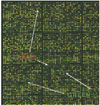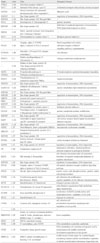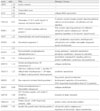Abstract
The purpose of this study was to characterize functional distinction between human dental pulp cells(PC) and periodontal ligament cells(PDLC) using cDNA microarray assay and to confirm the results of the microarray assay using RT-PCR. 3 genes out of 51 genes which were found to be more expressed(>2 fold) in PC were selected, and 3 genes out of 19 genes which were found to be more expressed(>2 fold) in PDLC were selected for RT-PCR as well.
According to this study, the results were as follows:
1. From the microarray assay, 51 genes were more expressed (2 fold) from PC than PDLC.
2. RT-PCR confirmed that ITGA4 and TGF β2 were more expressed in PC than in PDLC.
3. From the microarray assay, 19 genes were more expressed (2 fold) from PDLC than PC.
4. RT-PCR confirmed that LUM, WISP1, and MMP1 were more expressed in PDLC than in PC.
From the present study, different expression of the genes between the PC and PDLC were characterized to show the genes which play an important role in dentinogenesis were more expressed from PC than PDLC, while the genes which were related with collagen synthesis were more expressed from PDLC than PC.
Figures and Tables
 | Figure 3M-A plot
The log ratios(M=log2R/G) are plotted on the y-axis against the log of the geometric mean of the signal intensities (A=log2R×G/2). M, expression ratio; A, signal intensity; R, Red for Cy5; G, Green for Cy3.
|
 | Figure 4Confirmation of differentially expressed genes observed in microarray results. Three genes (ITGA, NEFH, TGF β2) selected from the genes express more than two fold in pulp cells than periodontal ligament cells were analysed by RT-PCR. |
 | Figure 5Confirmation of differentially expressed genes observed in microarray results. Three genes (MMP1, WISP, LUM) selected from the genes express more than two fold in periodontal ligament cells than pulp cells were analysed by RT-PCR. |
References
1. Ruch JV. Linde A, editor. Tooth morphogenesis and differentiation. Dentin and Dentinogenesis. 1984. Boca Raton, FL: CRC press;47–79.
2. Kikuchi H, Sawada T, Yahnagisawa T. Effects of a functional agar surface on in vitro dentinogenesis induced in proteolytically isolated agar-coated dental papillae in rat mandibular incisors. Arch Oral Biol. 1996. 41:871–883.

3. Ruch JV. Odontoblast differentiation and the formation of the odontoblast layer. J Dent Res. 1985. 64 Spec No:489–498.
4. Osman M, Ruch JV. Behavior of odontoblast and basal lamina of trypsin or EDTA-isolated mouse dental papillae in short-term culture. J Dent Res. 1981. 60:1015–1027.

6. Gronthos S, Brahim J, W Li, Fisher LW, Cherman N, Boyde A, Denbesten P, Gehron Robey P, Shi S. Stem Cell Properties of Human Dental Pulp Stem Cells. J Dent Res. 2002. 81(8):531–535.

7. Gronthos S, Mankani M, Brahim J, Robey PG, Shi S. Postnatal human dental pulp stem cells (DPSCs) in vitro and in vivo. Proc Natl Acad Sci. 2000. 97:13625–13630.
8. Miura M, Gronthos S, Zhao M, Lu B, Fisher LW, Robey PG, Shi S. SHED: Stem cells from human exfoliated decidous teeth. Proc Natl Acad Sci. 2003. 100:5807–5812.
9. McCulloch CA. Origin and function of cells essential for periodontal repair: the role of fibroblasts in tissue homeostasis. Oral Dis. 1995. 1(4):271–278.

10. Seo BM, Miura M, Gronthos S, Bartold PM, Batouli S, Brahim J, Young M, Robey PG, Wang CY, Shi S. Investigation of multipotent postnatal stem cells from human periodontal ligament. Lancet. 2004. 364:149–155.

11. Pääkkönen V, Ohlmeier S, Bermann U, Larmas M, Salo T, Tjäderhane L. Analysis of gene and protein expression in healthy and carious tooth pulp with cDNA microarray and two-dimensional gel electrophoresis. Eur J Oral Sci. 2005. 113:369–379.

12. Shi S, Robey PG, Gronthos S. Comparison of Human Dental Pulp and Bone Marrow Stromal Cells by cDNA Microarray Analysis. Bone. 2001. 29:532–539.

13. Wang PL, Ohura K, Fujii T, Oido-Mori M, Kowashi Y, Kikuch M, Suetsugu Y, Tanaka J. DNA microarray analysis of human gingival fibroblasts from healthy and inflammatory gingival tissues. Biochem Biophys Res Commun. 2003. 305:970–973.

14. Han X, Bolcato L, Amar S. Identification of Genes Differentially Expressed in Cultured Human Osteoblasts Versus Human Fibroblasts by DNA Microarray Analysis. Connect Tissue Res. 2002. 43:63–75.

15. Nair PNR. Pathogenesis of Apical Periodontitis and the Cause of Endodontic Failures. Crit Rev Oral Biol Med. 2004. 15(6):348–381.

16. Anand PS, Nandakumar K. Management of Periodontitis Associated with Endodontically Involved Teeth: A Case Series. J Contemp Dent Pract. 2005. 6(2):118–129.

17. Satchell PG, Gutmann JL, Witherspoon DE. Apoptosis: an introduction for the endodontist. Int Endod J. 2003. 36:237–245.

18. Han X, Amar S. Identification of genes differentially expressed in cultured human periodontal ligament fibroblasts vs. human gingival fibroblasts by DNA microarray analysis. J Dent Res. 2002. 81(6):399–405.

19. Chen S, Santos L, Wu Y, Vuong R, Gay I, Schulze J, Chuang HH, MacDougall M. Altered gene expression in human cleidocranial dysplasia dental pulp cells. Arch Oral Biol. 2005. 50:227–236.

20. Kamata N, Fujimoto R, Tomonari M, Taki M, Nagayama M, Yasumoto S. Immortalization of human dental papilla, dental pulp, periodontal ligament cells and gingival fibroblasts by telomerase reverse transcriptase. J Oral Pathol Med. 2004. 33:417–423.

21. Silva TA, Rosa AL, Lara VS. Dentin matrix proteins and soluble factors: intrinsic regulatory signals for healing and resorption of dental and periodontal tissues. Oral Diseases. 2004. 10:63–74.

22. Asano M, Kubota S, Nakanishi T, Nishida T, Yamaai T, Yosimichi G, Ohyama K, Sugimoto T, Murayama Y, Takigawa M. Effect of connective tissue growth factor (CCN2/CTGF) on proliferation and differentiation of mouse periodontal ligament-derived cells. Cell Commun Signal. 2005. 3:11.

23. Zhu Q, Safavi KE, Spanberg LS. Intergin expression in human dental pulp cells and their role in cell attachment on extracellular matrix proteins. J Endod. 1998. 24(10):641–644.

24. Luthman J, Luthman D, Hokfelt T. Occurrence and distribution of different neurochemical markers in the human dental pulp. Arch Oral Biol. 1992. 37(3):193–208.

25. Beck LS. In vivo induction of bone by recombinant human transforming growth factor beta 1. J Bone Miner Res. 1991. 6:961–968.

26. Machwate M, Julienne A, Moukhtar M. Temporal variation of c-fos proto-oncogene expression during osteoblast differentiation and osteogenesis in developing rat bone. J Cell Biochem. 1995. 57:62–70.

27. Centrella M, McCarthy TL, Canalis E. Transforming growth factor beta and remodeling of bone. J Bone Joint Surg Am. 1991. 73:1418–1428.
28. Ingram RT, Bonde SK, Riggs BL, Fitzpatrick LA. Effects of transforming growth factor beta and 1,25-dihydroxyvitamin D3 on the function, cytochemistry and morphology of normal human osteoblast-like cells. Differentiation. 1994. 55:153–163.

29. Ripamonti U, Duneas N, VandenHeever B, Bosch C, Crooks J. Recombinant transforming growth factor beta induces endochondral bone in the baboon and synergizes with recombinant osteogenic protein-1(bone morphorgenetic protein-7) to initiate rapid bone formation. J Bone Miner Res. 1997. 12:1584–1595.

30. Rosen D, Miller SC, DeLeon E, Thompson AY, Bentz H, Mathews M, Adams S. Systemic adminstration of recombinant transforming growth factor beta 2 stimulates parameters of cancellous bone formation in juvenile and adult rats. Bone. 1994. 15:355–359.

31. Toyono T, Nakashima M, Kuhara S, Akamine A. Expression of TGF-beta superfamily receptors in dental pulp. J Dent Res. 1997. 76:1555–1560.

32. Sloan AJ, Matthews JB, Smith AJ. TGF-beta receptor expression in human odontoblasts and pulp cells. Histochem J. 1999. 31:565–569.
33. Gusman H, Santana RB, Zehnder M. Matrix metalloproteinase and gelatinolytic activity in clinically healthy and inflammed human dental pulps. Eur J Oral Sci. 2002. 110(5):353–357.

34. Shin SJ, Lee JI, Baek SH, Lim SS. Tissue levels of matrix metalloproteinase in pulps and periapical lesions. J Endod. 2002. 28(4):313–315.

35. Lin SK, Wang CC, Huang S, Lee JJ, Chiang CP, Lan WH, Hong CY. Induction of dental pulp fibroblast matrix metalloproteinase-1 and tissue inhibitor of metalloproteinase-1 gene expression by interleukin-1 alpha and tumor necrosis factor alpha through a prostaglandin-dependent pathway. J Endod. 2001. 27(3):185–189.

36. Ababneh KT, Hall RC, Embery G. The proteoglycans of human cementum : immunohistochemcal localization in healthy, periodontally involved and ageing teeth. J Periodontal Res. 1999. 34(2):87–96.





 PDF
PDF ePub
ePub Citation
Citation Print
Print







 XML Download
XML Download